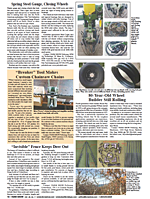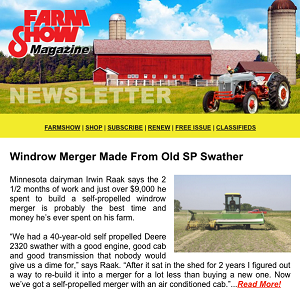How To Set Up A Wild Bee Nursery
 ✖  |
Instead of renting honeybees, it may be more economically feasible for small fruit and orchard producers to attract their own wild bees. It's not that difficult according to James Cane, a research entomologist with USDA's Agricultural Research Service. In his work with fruit growers in western states, he attracts egg-laying female bees to plastic totes filled with straws, or to blocks of wood with holes drilled in them.
You have to provide nesting holes, Cane says, to mimic the natural deadwood cavities wild bees need for laying their eggs.
One of his favorite designs is a "BeeMail" shelter that begins with a corrugated, polyethylene plastic tote placed on its side. The totes, used by the U.S Postal Service, sell for $14 at www.postalproducts.com. They're reinforced with 1/4-in wire rims and don't break down in the sun. They should last for years, especially if they're only outside during bloom time. The totes are light, stackable and can be easily mounted on poles. The 14.3-in. tall models are deep enough to hold 6-in. deep nesting cavities with enough overhang to protect them from rain.
The space can be subdivided in a variety of ways, with foam or wooden blocks or even with 2-quart milk cartons, stuffed with paper drinking straws.
Cane describes how the tote nurseries work with the wild orchard bees he manages. "Each female progressively subdivides each tunnel into a series of nest cells," he explains, "with each cell receiving a pea-sized provision of pollen moistened with nectar, followed by a single egg. Nest cells are partitioned, and ultimately capped with mud."
The bees lay five to seven eggs in each 6-in. tunnel. They lay fertilized eggs (females) first and unfertilized eggs (males) last in the front of the tunnel. Male bees hatch in less time, so they'll break through their cells about the same time as the eggs laid earlier. One tote can accommodate as many as 3,000 bees ù enough to pollinate a 1/2 to 1-acre orchard.
Cane says he prefers to use paper straws because they can be removed and replaced to prevent disease. Other materials can also be used to create bee-nesting cavities, from foam blocks to dry, round, conifer blocks of wood with 5/16-in. diameter holes drilled across the grain.
Cane suggests placing the totes on metal T-posts with a support frame. One frame is commercially available at www.quiedan.com. But he notes that resourceful growers can come up with their own attachment ideas.
"You want sun on the bee's nest entrances early in the morning," Cane says. "Place them chest high where it's easy to work on them. Select bright color totes for visibility. Also avoid bee-toxic insecticides during bloom and make sure sprinklers don't reach the opening."
Cane shares bee nursery building ideas at www.ars.usda.gov/npa/beelab. Within a few years it's possible to double and triple the number of pollinating wild bees if the nesting is managed well.
As a bonus, wild bees do not sting like honey bees, which the neighbors will appreciate, Cane adds.
Contact: FARM SHOW Followup, James H. Cane, USDA-ARS Bee Biology and Systematics Lab, Utah State University, Logan, Utah 84322 (ph 435 797-3879; Jim.Cane@ars.usda.gov; www.ars.usda.gov/npa/beelab).

Click here to download page story appeared in.
Click here to read entire issue
How To Set Up A Wild Bee Nursery CROPS Miscellaneous Instead of renting honeybees it may be more economically feasible for small fruit and orchard producers to attract their own wild bees It s not that difficult according to James Cane a research entomologist with USDA s Agricultural Research Service In his work with fruit growers in western states he attracts egg-laying female bees to plastic totes filled with straws or to blocks of wood with holes drilled in them
You have to provide nesting holes Cane says to mimic the natural deadwood cavities wild bees need for laying their eggs
One of his favorite designs is a BeeMail shelter that begins with a corrugated polyethylene plastic tote placed on its side The totes used by the U S Postal Service sell for $14 at www postalproducts com They re reinforced with 1/4-in wire rims and don t break down in the sun They should last for years especially if they re only outside during bloom time The totes are light stackable and can be easily mounted on poles The 14 3-in tall models are deep enough to hold 6-in deep nesting cavities with enough overhang to protect them from rain
The space can be subdivided in a variety of ways with foam or wooden blocks or even with 2-quart milk cartons stuffed with paper drinking straws
Cane describes how the tote nurseries work with the wild orchard bees he manages Each female progressively subdivides each tunnel into a series of nest cells he explains with each cell receiving a pea-sized provision of pollen moistened with nectar followed by a single egg Nest cells are partitioned and ultimately capped with mud
The bees lay five to seven eggs in each 6-in tunnel They lay fertilized eggs females first and unfertilized eggs males last in the front of the tunnel Male bees hatch in less time so they ll break through their cells about the same time as the eggs laid earlier One tote can accommodate as many as 3 000 bees ù enough to pollinate a 1/2 to 1-acre orchard
Cane says he prefers to use paper straws because they can be removed and replaced to prevent disease Other materials can also be used to create bee-nesting cavities from foam blocks to dry round conifer blocks of wood with 5/16-in diameter holes drilled across the grain
Cane suggests placing the totes on metal T-posts with a support frame One frame is commercially available at www quiedan com But he notes that resourceful growers can come up with their own attachment ideas
You want sun on the bee s nest entrances early in the morning Cane says Place them chest high where it s easy to work on them Select bright color totes for visibility Also avoid bee-toxic insecticides during bloom and make sure sprinklers don t reach the opening
Cane shares bee nursery building ideas at www ars usda gov/npa/beelab Within a few years it s possible to double and triple the number of pollinating wild bees if the nesting is managed well
As a bonus wild bees do not sting like honey bees which the neighbors will appreciate Cane adds
Contact: FARM SHOW Followup James H Cane USDA-ARS Bee Biology and Systematics Lab Utah State University Logan Utah 84322 ph 435 797-3879; Jim Cane@ars usda gov; www ars usda gov/npa/beelab
To read the rest of this story, download this issue below or click
here to register with your account number.







